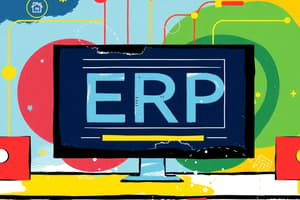Podcast
Questions and Answers
Match the following features with their corresponding benefits of automating employee tracking systems:
Match the following features with their corresponding benefits of automating employee tracking systems:
Eliminates manual processes = Saves time and reduces errors Better analysis = Improves data insights More control = Enhances workforce management Real-time information access = Facilitates quick staffing adjustments
Match the companies with their selected software systems:
Match the companies with their selected software systems:
Banner Health = Kronos Inc. Smurfit-Stone Container Corp = Workbrain Inc. SAP financial applications = ERP systems integration PeopleSoft = Payroll processing
Match the descriptions with the respective ERP system features:
Match the descriptions with the respective ERP system features:
HR modules = Records management and benefits administration Scalable = Adaptable to company growth Flexible = Customizable to meet specific needs Integrated controls = Operational and strategic oversight
Match the problems with their solutions as discussed in the article:
Match the problems with their solutions as discussed in the article:
Match the software features with their advantages for employees:
Match the software features with their advantages for employees:
Match the HR problems with their descriptions:
Match the HR problems with their descriptions:
Match the ERP HR modules with their functionalities:
Match the ERP HR modules with their functionalities:
Match the HR attributes with their characteristics:
Match the HR attributes with their characteristics:
Match the management control levels with their descriptions:
Match the management control levels with their descriptions:
Match the automated HR system features with their benefits:
Match the automated HR system features with their benefits:
Match the challenges faced by Atlantic Manufacturing with their impacts:
Match the challenges faced by Atlantic Manufacturing with their impacts:
Match the components of ERP HR modules with their responsibilities:
Match the components of ERP HR modules with their responsibilities:
Match the terms with their definitions related to ERP HR systems:
Match the terms with their definitions related to ERP HR systems:
Match the features of automated time and attendance records with their advantages:
Match the features of automated time and attendance records with their advantages:
What is a primary benefit of automating employee tracking systems?
What is a primary benefit of automating employee tracking systems?
Which of the following is a capability provided by the software selected by Banner Health?
Which of the following is a capability provided by the software selected by Banner Health?
Which company uses Workbrain Inc.’s ERM3 for employee relationship management?
Which company uses Workbrain Inc.’s ERM3 for employee relationship management?
What kind of controls do ERP systems HR modules offer?
What kind of controls do ERP systems HR modules offer?
What issue often arises from manual tracking of employee records?
What issue often arises from manual tracking of employee records?
What is a major benefit of integrating HR systems with financial systems in ERP?
What is a major benefit of integrating HR systems with financial systems in ERP?
Which of the following is NOT a challenge faced by Atlantic Manufacturing in its HR processes?
Which of the following is NOT a challenge faced by Atlantic Manufacturing in its HR processes?
What attribute of ERP HR modules primarily allows for efficient electronic routing of documents?
What attribute of ERP HR modules primarily allows for efficient electronic routing of documents?
How does human capital inventory within ERP systems aid in HR management?
How does human capital inventory within ERP systems aid in HR management?
Which of the following tasks would be best supported by an HR Management module in an ERP system?
Which of the following tasks would be best supported by an HR Management module in an ERP system?
What is the purpose of having audit trails within ERP HR modules?
What is the purpose of having audit trails within ERP HR modules?
Which HR function is focused on evaluating job roles and responsibilities?
Which HR function is focused on evaluating job roles and responsibilities?
What does the employee/manager self-service feature primarily enable?
What does the employee/manager self-service feature primarily enable?
Which of the following describes a significant benefit of module integration in ERP HR systems?
Which of the following describes a significant benefit of module integration in ERP HR systems?
What is a key characteristic of ERP HR systems that enhances data management?
What is a key characteristic of ERP HR systems that enhances data management?
Flashcards
Automated employee tracking
Automated employee tracking
Using technology to automatically record and manage employee attendance, time, and skills.
Benefits of automation
Benefits of automation
Automated systems eliminate manual processes, reduce errors, allow for better analysis and control of employee data.
Real-time employee data
Real-time employee data
Employee information available immediately, allowing for quick adjustments in staffing.
Integrated HR modules
Integrated HR modules
Signup and view all the flashcards
Scalable ERP systems
Scalable ERP systems
Signup and view all the flashcards
ERP HR Modules
ERP HR Modules
Signup and view all the flashcards
HR Processes Supported by ERP
HR Processes Supported by ERP
Signup and view all the flashcards
Stand-alone HR Systems
Stand-alone HR Systems
Signup and view all the flashcards
Integration (ERP)
Integration (ERP)
Signup and view all the flashcards
Common Database (ERP)
Common Database (ERP)
Signup and view all the flashcards
Benefits Administration (ERP)
Benefits Administration (ERP)
Signup and view all the flashcards
Payroll (ERP)
Payroll (ERP)
Signup and view all the flashcards
Employee Self-Service
Employee Self-Service
Signup and view all the flashcards
Scalability and Flexibility (ERP)
Scalability and Flexibility (ERP)
Signup and view all the flashcards
Workflow Management (ERP)
Workflow Management (ERP)
Signup and view all the flashcards
HR Problems Solved by ERP
HR Problems Solved by ERP
Signup and view all the flashcards
ERP vs Stand-alone HR Systems
ERP vs Stand-alone HR Systems
Signup and view all the flashcards
Benefits of ERP for HR
Benefits of ERP for HR
Signup and view all the flashcards
What is a Common Database in ERP?
What is a Common Database in ERP?
Signup and view all the flashcards
How is Employee Self-Service Useful?
How is Employee Self-Service Useful?
Signup and view all the flashcards
What does 'Scalability and Flexibility' mean?
What does 'Scalability and Flexibility' mean?
Signup and view all the flashcards
The Importance of Integration in ERP
The Importance of Integration in ERP
Signup and view all the flashcards
What are the Benefits of Workflow Management?
What are the Benefits of Workflow Management?
Signup and view all the flashcards
What are the Control Levels in ERP for HR?
What are the Control Levels in ERP for HR?
Signup and view all the flashcards
How is 'Process Standardization' beneficial?
How is 'Process Standardization' beneficial?
Signup and view all the flashcards
Manual vs. Automated Employee Tracking
Manual vs. Automated Employee Tracking
Signup and view all the flashcards
Benefits of Automated Employee Tracking
Benefits of Automated Employee Tracking
Signup and view all the flashcards
Real-time Employee Information
Real-time Employee Information
Signup and view all the flashcards
Employee Relationship Management (ERM)
Employee Relationship Management (ERM)
Signup and view all the flashcards
ERP HR Modules: Integrated and Scalable
ERP HR Modules: Integrated and Scalable
Signup and view all the flashcards
Study Notes
Chapter 7: ERP Systems: Human Resources
- ERP systems support human resource processes
- ERP systems link business processes involved in human resource management
- Atlantic Manufacturing case study exhibits difficulties in recruitment, training, retention, HR record keeping, increasing paperwork demands, compensation package management, and employee benefit costs.
Human Resource Problems
- Maintaining accurate employee information
- Job analysis and design
- Applicant selection
- Compensation
- Benefit administration
- Training
- Governmental reporting
Evolution of HR Systems
- Traditionally, HR systems were stand-alone. This meant specialized systems for applicant tracking, compensation, benefits, and attendance, often leading to redundant data and lacking links to financial systems.
- ERP systems, offering links to financial systems. ERP aims for "best practices."
ERP HR Modules
- Components include HR management (personnel records, resumes), benefits administration (links employee data to actual benefits, supports selections from group benefits), and payroll (paychecks, tax reports, accounting data, time and labor management, employee/manager self-service, travel reimbursement, personnel data and benefit changes, training classes).
HR Modules: Attributes
- Integration (common database, audit trails)
- Scalable and flexible (drill-down capability)
- Workflow management (electronic routing of documents)
- Process standardization
- Security
- User-friendly and web-accessible
Questions and Decisions (HRM Decisions Supported by ERP)
- Recruiting: Internal candidate qualifications (e.g., marketing, bilingual skills). Effective sourcing (universities, websites, referrals, search firms). Identifying top managers' characteristics (education, experience). IT professional requirements.
- Job Analysis: Identifying jobs with high turnover. Identifying skill gaps in HR professionals.
- Compensation: Competitive salary and compensation packages. Impact of various pay plans on retention and promotion. External market salary analysis. Employee benefit cost control.
- Benefits: Employee self-selection of benefits to reduce costs; planning for employee retirements.
- Workforce development: Future workforce skills needs. Short-term and long-term HR needs. Implications of workforce needs on training and development. Impact of mergers on development and retention. Workforce availability for specific locations.
Management Control Modules
- HR information supports diverse workforce management.
- Supports managerial decisions using query and reporting tools.
- Operational level controls include maintaining and updating employee files, job analysis data, design files, regulatory files, and skills inventory files.
- Strategic level controls include human capital inventory tracking, position control to budgeting, labor/management relationships, and predicting trends using business intelligence tools.
Featured Article: Keep Track of Your Employees
- Benefits of automated time and attendance systems.
- Pros and cons of employee time tracking systems. Automated systems eliminate manual processes, reduce errors, and provide better analysis and control. Employee attendance, time at work, and skill levels are often uncertain to track. Manual records are often neglected and done piece meal.
- Banner Health uses Kronos software for time and labor management. Accessible through web, phone, and badge terminals. Real-time information enables quick staffing adjustments and provides benefits to employees.
- Smurfit-Stone Container uses Workbrain's ERM3, SAP financial applications, and PeopleSoft payroll. Web-based employee relationship management and optimized scheduling, tracking employee interfaces, PeopleSoft applications
Summary
- ERP systems have HR modules for record management, benefits administration and payroll.
- Integrated operational and strategic controls.
- ERP systems' scalability and flexibility are significant benefits.
Studying That Suits You
Use AI to generate personalized quizzes and flashcards to suit your learning preferences.




